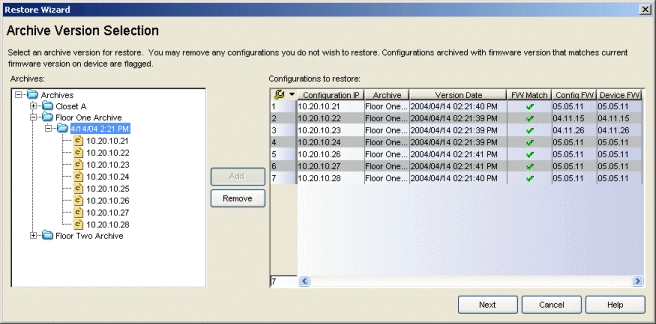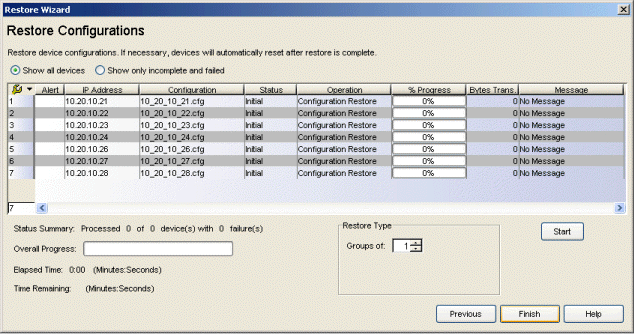Use the Restore Wizard to restore saved (archived) device configuration files to
one or more devices. Saved configurations are listed in the
left-panel Archive Mgmt tab under the
appropriate archive and version. Each configuration displays an icon that
identifies the type of data that was saved:
![]() device configuration data,
device configuration data, ![]() capacity planning
data,
capacity planning
data, ![]() both device configuration and capacity planning
data. Only configurations that include device configuration data (
both device configuration and capacity planning
data. Only configurations that include device configuration data ( ![]() and
and
![]() ) are available
to be restored.
) are available
to be restored.
A configuration can only be restored to a device with the same IP address. In other words, the device you are restoring to must have the same IP address as the device the configuration was originally saved from. You can restore configurations to a single device or multiple devices. You must have a TFTP or FTP server running to restore a configuration. For more information, see TFTP Server Setup or FTP Server Setup.
To access the wizard, select Tools > Wizards > Restore Wizard
from the menu bar or click ![]() on the toolbar.
on the toolbar.
Archive Version Selection Window
Use this window to select an archive version or single configuration to restore. If you select an archive version, you can use the Remove button to remove any individual configurations included in the archive version that you do not wish to restore.
Click the graphic for more information.

Archives
This panel displays your current archives just as they are listed in the
left-panel Archive Mgmt tab.
Below each archive name are the archive versions, displayed by the date
and time the version was performed. Under the versions are the individual configurations, listed by
IP address of the device whose configuration was saved.
Each configuration displays an icon that identifies the type of data that was
saved:
![]() device configuration data,
device configuration data, ![]() capacity planning
data,
capacity planning
data, ![]() both device configuration and capacity planning
data. Only configurations that include device configuration data (
both device configuration and capacity planning
data. Only configurations that include device configuration data ( ![]() and
and
![]() ) are available
to be restored.
) are available
to be restored.
Expand the folders under the Archives tree and select the archive version or configuration you want to restore. Click the Add button to add the configurations to the Configurations to Restore table.
| TIPS: | -- If you open the Restore Wizard from an archive version or configuration in the left-panel
Archive Mgmt tab,
the selected configuration(s) will be automatically displayed under Configurations to Restore. -- Check the FW Match column to see if the current firmware version on the device matches the firmware version that was on the device at the time of the archive. |
|---|
Configurations to Restore
Displays the configurations you have selected to restore. Select a configuration and use the Remove button to remove any individual configurations you do not wish to restore.
- FW Match
- A
 indicates that the current firmware version installed in the device matches
the firmware version installed in the device at the time of the
configuration save.
indicates that the current firmware version installed in the device matches
the firmware version installed in the device at the time of the
configuration save.
- Add Button
- In the Archives tree, select the archive version or configuration you want to restore, and click Add to add it to the Configurations to Restore table.
- Remove Button
- Select a configuration in the Configurations to Restore table, and click Remove to remove it from the table.
Restore Configurations Window
Use this window to configure restore parameters, initiate the restore operation, and monitor restore progress. Devices that require a reset will be reset automatically after the restore is complete.
Click the graphic for more information.

- Show all devices/Show only incomplete and failed
- Once the restore operation starts, the device list table updates with
status information for each device. An alert icon
 will appear in the Alert column of the table if a
restore
operation fails for a specific device. You can use these radio buttons to show all devices or show only those
devices whose restore operations are incomplete or have failed.
will appear in the Alert column of the table if a
restore
operation fails for a specific device. You can use these radio buttons to show all devices or show only those
devices whose restore operations are incomplete or have failed.
- Device List Table
- A list of the devices you have selected for
your restore operation. Once the restore is started, this table updates
with status information for the restore operation:
- Alert - an alert icon
 will
appear in the Alert column if a restore operation fails for a specific
device.
will
appear in the Alert column if a restore operation fails for a specific
device.
- IP Address - The device's IP address. Note that chassis that support Distributed Forwarding Engines (DFEs), such as the N-Series, display a single management IP even though there may be multiple DFE modules in the chassis.
- Configuration - The name of the configuration file being restored.
- Status - The status of the operation for that particular device: Success or Failure.
- Operation - The type of operation performed: Configuration Restore.
- % Progress - A progress bar showing the percent completed of the operation.
- Bytes Trans. - The number of bytes transferred during the operation.
- Message - A message relating to the status of the operation.
TIP: Use the table options and tools to find, filter, sort, print, and export information in a table and customize table settings. You can access the Table Tools through a right-mouse click on a column heading or anywhere in the table body, or by clicking the Table Tools  button in the
upper left corner of the table (if you have the row count column displayed). For more information, see the Suite-Wide Tools
Table Tools Help topic.
button in the
upper left corner of the table (if you have the row count column displayed). For more information, see the Suite-Wide Tools
Table Tools Help topic. - Alert - an alert icon
- Status Summary
- Once the restore is started, this area updates with status information for the restore operation.
- Restore Type
- The restore will be performed in
parallel (simultaneously) on the number of devices
specified in the Groups of field. By default, the restores will occur
in sequential order (Groups of: 1). This is to protect against possible
isolation of other devices that are on the restore list.
CAUTION: Because some devices automatically reset following a restore operation, performing a Restore Type greater than 1 may isolate other devices in the restore list, causing their restores to fail. It is recommended that you leave the Groups of value at 1 (perform the restore serially,) unless you know it is safe to have the selected network devices reset simultaneously.
- Start Button
- Initiates the restore operation. The table at the top of the window updates with status information, as will the status area in the bottom left of the window.
For information on related tasks: